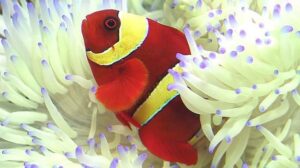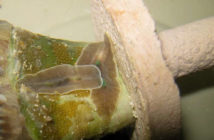
There’s no denying that clownfish are among the easiest aquarium fish to take care of. Not only are they low maintenance, but they seem to find a host quickly and live happily throughout their days. In the wild, these clownfish usually host in an anemone to survive. But in an aquarium where they generally feel safe, that may not always be the case. If your clownfish has been living in a tank for a long time, getting him to acclimate to anemones may be tricky. Nevertheless, it’s not impossible. That is why we decided to prepare this article for you.
Here, we will show you tips and tricks on how to acclimate clownfish to anemones. Soon enough, you will begin to see the beautiful symbiotic relationship between these aquatic creatures. However, pairing with anemones increases their life expectancy and ensures providing the best care for your clownfish.
Can All Species of Anemone Host Clownfish?
The biggest mistake that beginners make when trying to acclimate clownfish to anemones is getting the wrong type of anemone. Admittedly, it is tempting to buy the most colorful anemone for your clownfish. If it looks great in the aquarium, then it will work, right? Wrong. The problem is that not all species of anemone can host clownfish. The first thing you have to be familiar with are the types of anemones that can naturally bond with clownfish. The popular hosts are the bubble-tip anemone, the carpet anemone, the Sebae anemone, and the magnificent anemone. Either of these four types of anemone will naturally pair with a clownfish, so always keep that in mind before you start this process.

Gold Stripe Maroon with Sebae Anemone
Among these four, the bubble-tip anemone is the host to most clownfish species. Bubble-tip anemone or BTA is known for being low-maintenance, and this makes it ideal for beginners. Tank-propagated BTA is readily available, and this makes the acclimation process easier for you.
BTA can sometimes be less expensive than the other types of clownfish-friendly anemones. Thus, we highly recommend using BTA as a host for your clownfish, especially if you do not have a lot of time to take care of them.
How to Acclimate Clownfish to Anemones
Now that you know which types of anemones can be safely paired with clownfish, let’s now proceed to this article’s heart. We are now ready to teach you how to acclimate clownfish to anemones.
Remove His Home Territory
If you pay close attention to your clownfish, you will notice that it has what he considers as his home territory. This is especially true if your clownfish has been living comfortably in the tank for quite some time now. If this is the case, the anemone you recently added to your tank may simply be ignored by your clownfish. After all, they already feel comfortable inside the tank, so there’s no need to swim to the anemone for protection.
To acclimate the clownfish in this scenario, you have to remove the object your clownfish considers his home territory. Clownfish love establishing their colony, so they have to find a new host once the old one is gone.
Once clownfish are happily acclimated to the anemone, you can now restore your old aquarium landscape.
Alternatively, you might want to rearrange the underwater landscape on your tank. This seemingly new environment will prompt the clownfish to establish a new home territory with the anemone.
Add Bigger Fish
Another easy way to acclimate clownfish to anemones is to add bigger fish into your tank. By bigger fish, we do not mean adding predatory fish into the tank. Instead, we recommend adding fish that are slightly larger than the clownfish. By doing so, the clownfish will feel the need to be protected from these alien creatures. Since anemone provides clownfish with natural protection in the wild, it will instinctively swim to the anemone and make it his host. And this becomes the start of a beautiful symbiotic relationship. We suggest adding fish that can safely live harmoniously with your clownfish. If you have a reef thank then we suggest yellow tangs, reef safe angelfish, or a reef safe butterflyfish that are larger than your clownfish.
Transfer to a Smaller Tank
Another method to acclimate the clownfish to an anemone is to transfer them into a smaller tank temporarily. The smaller tank should only contain the anemone and the clownfish, so the latter won’t have anywhere else to go. In doing this, make sure that the tank is still big enough to submerge the anemone fully. Also, make sure that it won’t feel too restraining for your clownfish. Other experts suggest using your regular clownfish tank, but only filling it with enough water to submerge the anemone. This way, there won’t be much water for the clownfish to swim on, and he can immediately make the anemone his host. However, we must give you caution about using this method. Experts believe that putting your clownfish in a tank that’s too small can lead to a lot of stress. Thus, use this only if the other two methods do not work.
Tips and Tricks
Before ending this article, we also want to leave you with several tips and tricks to make sure that both the clownfish and the anemone will be happily living in your tank.
1. Make sure that the tank is big enough to host both of these aquatic creatures. It is recommended for a single or pair of clownfish to be housed in a 20-gallon tank or larger. If you want to add more clownfish, add another 10 gallons for each fish but it is possible to have more fish in the tank if they are small in size.
2. While clownfish and BTA are generally low maintenance, you should always remember to practice good husbandry as you would with any aquarium.
3. As much as possible, try to mimic the natural movement of the water in their natural habitat. You can invest in water circulation pumps or wave makers but be sure to cover your waver makers pumps with a foam mesh guard. Anemones can wander and you don’t what your prized anemone to become dismembered by the wavemaker prop.

Ecotech Marine MP40 Wavemaker with optional foam guard
4. And finally, make sure to do your research about the anemone you are planning to purchase. Different types of anemones require different degrees of care, especially in terms of lighting and cleanliness. Like anything, if you don’t take care of it properly, it will die, and your clownfish will be left with no host.
Final Takeaway
Now that you know how to acclimate clownfish with anemones, we hope that you will also take good care of both species. While their symbiotic relationship will help them survive on their own, you also have to do your part to make sure that the tank is livable for both of them.
By observing the tips we’ve discussed above, we guarantee that your clownfish will host in the anemone with no problem. While it may take some time, you must be patient and ensure that the clownfish won’t be too stressed out during the host change.
Author’s Bio
Sujit Modak is the owner of the fishkeeping blog Aquarium Tales. He is an experienced aquarist. He successfully experimented with a complex ecosystem inside aquariums. Biotope aquariums and aquaponics are the fields of his interest.





